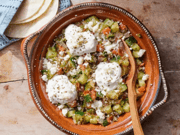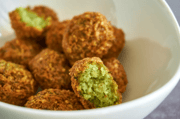Is falafel really as healthy as it seems?
- Replies 0
Golden, crunchy, and bursting with flavour, falafel has become one of those foods that feels both indulgent and wholesome at the same time.
It shows up everywhere now—from busy café counters to trendy bowls stacked with grains and greens—promising a filling plant-based bite that pleases vegetarians and meat-eaters alike.
Many of us happily assume it’s a guilt-free choice because of its wholesome ingredients and Mediterranean roots.
But as with many foods that carry a “health halo,” there are details worth looking at more closely before declaring it a perfect option.
At its simplest, falafel is a mix of chickpeas or fava beans blended with onion, garlic, parsley, coriander, and spices, shaped into small patties or balls.
The traditional version is deep-fried, giving it that irresistible crunch, though more modern takes often swap in baking or air-frying for a lighter finish.
It is usually tucked into pita bread or paired with salad and tahini, but it’s also showing up in wraps, bowls, and even burgers. No matter the format, its versatility has helped cement falafel as a global favourite.
Nutritionally, the foundation is solid. Legumes like chickpeas are full of protein and fibre, which help keep you satisfied and support healthy digestion.
They also have a naturally low glycaemic index, which means they provide slow, steady energy rather than spiking blood sugar levels.
Add to that a generous dose of vitamins and minerals—from iron and folate to potassium and magnesium—and you can see why falafel earns praise as a nourishing option.
The catch lies in how it’s prepared and served. Deep-frying adds a hefty amount of oil, which drives up the calorie and fat content in ways many people don’t realise.
Restaurant or packaged falafel often comes with far more sodium than homemade versions, and when you throw in creamy sauces, salty pickles, and refined breads, what started out as a nutrient-dense dish can quickly turn into a less balanced meal.
Portion size also matters, since eating a big pile of falafel balls can undo the benefits that come with moderation.
That doesn’t mean you need to give it up—it just means a few tweaks make it much healthier. Baking or air-frying delivers nearly the same crunch with a fraction of the fat, and choosing wholegrain wraps instead of white pita boosts fibre intake.
Pairing falafel with plenty of fresh vegetables helps balance out the heavier elements, while keeping sauces to a drizzle rather than a pour keeps calories and sodium in check.
Paying attention to these small adjustments can make falafel a regular part of a health-conscious diet without the hidden drawbacks.
For older adults especially, falafel can be a smart way to enjoy more plant-based meals. The combination of protein, fibre, and micronutrients supports heart and bone health, while also providing a satisfying alternative to meat.
Cost-wise, it’s often affordable, especially if you make it at home. With a little care in preparation, falafel can be both a comfort food and a genuinely good-for-you staple.
Read next:

Do you make falafel at home, or do you usually order it when you’re out? Have you found tricks for making it lighter, or do you stick with the traditional fried version because you love the crunch? Share your favourite recipes, cooking methods, or local spots in the comments below so others can give them a try. Sometimes the best ideas come straight from the community.
It shows up everywhere now—from busy café counters to trendy bowls stacked with grains and greens—promising a filling plant-based bite that pleases vegetarians and meat-eaters alike.
Many of us happily assume it’s a guilt-free choice because of its wholesome ingredients and Mediterranean roots.
But as with many foods that carry a “health halo,” there are details worth looking at more closely before declaring it a perfect option.
At its simplest, falafel is a mix of chickpeas or fava beans blended with onion, garlic, parsley, coriander, and spices, shaped into small patties or balls.
The traditional version is deep-fried, giving it that irresistible crunch, though more modern takes often swap in baking or air-frying for a lighter finish.
It is usually tucked into pita bread or paired with salad and tahini, but it’s also showing up in wraps, bowls, and even burgers. No matter the format, its versatility has helped cement falafel as a global favourite.
Nutritionally, the foundation is solid. Legumes like chickpeas are full of protein and fibre, which help keep you satisfied and support healthy digestion.
They also have a naturally low glycaemic index, which means they provide slow, steady energy rather than spiking blood sugar levels.
Add to that a generous dose of vitamins and minerals—from iron and folate to potassium and magnesium—and you can see why falafel earns praise as a nourishing option.
The catch lies in how it’s prepared and served. Deep-frying adds a hefty amount of oil, which drives up the calorie and fat content in ways many people don’t realise.
Restaurant or packaged falafel often comes with far more sodium than homemade versions, and when you throw in creamy sauces, salty pickles, and refined breads, what started out as a nutrient-dense dish can quickly turn into a less balanced meal.
Portion size also matters, since eating a big pile of falafel balls can undo the benefits that come with moderation.
That doesn’t mean you need to give it up—it just means a few tweaks make it much healthier. Baking or air-frying delivers nearly the same crunch with a fraction of the fat, and choosing wholegrain wraps instead of white pita boosts fibre intake.
Pairing falafel with plenty of fresh vegetables helps balance out the heavier elements, while keeping sauces to a drizzle rather than a pour keeps calories and sodium in check.
Paying attention to these small adjustments can make falafel a regular part of a health-conscious diet without the hidden drawbacks.
For older adults especially, falafel can be a smart way to enjoy more plant-based meals. The combination of protein, fibre, and micronutrients supports heart and bone health, while also providing a satisfying alternative to meat.
Cost-wise, it’s often affordable, especially if you make it at home. With a little care in preparation, falafel can be both a comfort food and a genuinely good-for-you staple.
Read next:
- More protein than an egg? These 3 nuts make the cut, says a nutrition expert
- Dietitian's secret: Discover the ultimate protein that slashes cholesterol levels!
Key Takeaways
- Falafel is made from legumes like chickpeas or fava beans blended with herbs and spices, then shaped and cooked.
- Its base ingredients provide protein, fibre, and nutrients such as folate, potassium, magnesium, and iron, which support heart and digestive health.
- Traditional deep-frying adds extra fat and calories, and packaged or restaurant falafel can be higher in sodium, especially when combined with sauces and pickles.
- Baking or air-frying, using wholegrain breads, and adding plenty of vegetables are the easiest ways to make falafel a healthier part of your diet.







